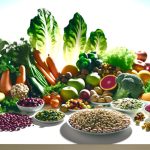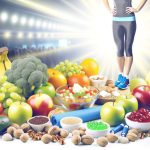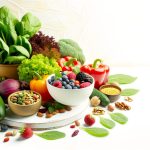It often seems like every food item in the grocery store is attempting to persuade shoppers that it is the most nutritious and most remarkable of all. We are going to reveal to you how to select some truly nourishing items, and then capitalize on them!
What is healthy food?
Food that is deemed nutritious typically has a balance of beneficial nutrients to negative items. Beans are a nutritional powerhouse, containing a variety of essential vitamins, minerals and proteins while having minimal amounts of fat. However, red meat is a source of protein but is also particularly high in fat and various additives used during processing.
What is fiber?
Much of us connect fiber with gut health and excretory system activity. Consuming items that are loaded in dietary fiber can do more than just ensure proper digestion. It has the potential to reduce the likelihood of cardiovascular diseases, strokes and diabetes, enhance the appearance of your skin and aid you to shed excess weight. It may even help prevent colon cancer.
Fiber, colloquially referred to as roughage, is the element of plant-based food sources (grains, fruits, vegetables, nuts, and beans) that can’t be processed by the body. This substance goes through the body without being broken down, thus cleaning out the digestive system and aiding in the passage of waste. It also helps with getting rid of bad cholesterol and toxic cancer-causing chemicals.
Fiber comes in two varieties: insoluble and soluble.
Insoluble fiber does not dissolve in water. The fiber that aids in the prevention of constipation is often more substantial in size and can be found in full-grain wheat products, grains, and vegetables such as carrots, celery, and tomatoes.
Water-soluble fiber aids in the regulation of blood sugar and cholesterol levels by breaking down during dissolution. Whole grains like barley and oatmeal, legumes such as beans, various nuts, and fruits like apples, raspberries, oranges, and pears are all great options.
Many foods contain both soluble and insoluble fiber. Generally, the closer a food is to its natural state, the higher the quantity of fiber it contains. There is no fiber in meat, dairy, or sugar. Foods that are processed and stripped of their fiber, such as white bread, white rice and baked goods, are known as “refined” or “white” items.
The Health Benefits of Fiber
Statistics indicate that almost everyone in the United States is not consuming their daily requirement of dietary fiber, and this is also a problem worldwide. It is possible that there is a correlation between this issue and what people usually do in the restroom. Fiber has more to offer than just helping us maintain regularity; it is an important part of a healthy diet. Research from numerous sources have demonstrated that including a substantial amount of fiber in your diet can aid in shielding your body from disease, and significantly develop your overall health, beauty, and well-being.
Some of the benefits include:
Digestive Health
Eating fiber helps to regulate bowel movements by increasing the volume of the stool and making it easier to pass. This may assist in alleviating and avoiding both irregularity and loose stools. Consuming an ample amount of fiber may help alleviate the chances of one developing diverticulitis (swelling of the digestive system), hemorrhoids, gallstones, kidney stones, as well as offering some reprieve to those with IBS (irritable bowel syndrome). Research indicates that a diet rich in fiber could be beneficial in decreasing stomach acid and lessening one’s likelihood of developing GERD or ulcers.
Diabetes
Eating foods containing a high amount of dietary fiber, especially insoluble fibers found in cereals, has been shown to reduce one’s chances of developing Type 2 diabetes. For those living with diabetes, consuming soluble fiber can slow the rate of sugar entering the bloodstream, thus bringing improvement to blood glucose levels.
Some studies indicate that eating a diet high in fiber may guard against colorectal cancer, though the evidence is still unclear. Eating meals that are filled with lots of high-fiber foods has been linked to a slight decrease in the chance of getting certain types of digestive system cancers, such as those that affect the stomach, mouth, and throat area.
Skin Health
When yeast and fungi are released from the skin, they can be the cause of outbreaks of acne. Including psyllium husk (a form of vascular plant seed) in your diet can assist in eliminating toxins from the body, thus enhancing the look and wellbeing of the skin.
Heart Health
Including fiber, especially soluble fiber, in one’s diet is beneficial for heart health. Consuming a diet with a great amount of fiber can increase cholesterol values by decreasing LDL (negative) cholesterol. Eating a lot of fiber can help lower the chance of having metabolic syndrome, which is related to coronary heart maladies, diabetes, and stroke. Fiber can have a positive effect on blood pressure, inflammation, the ratio of HDL cholesterol, and assist in the loss of extra abdominal fat.
READ MORE: 5 Lifestyle Changes To Lower Your Cholesterol
Tips for Adding Fiber to your Diet:
Nutritionists suggest that based on your age and sex, you should consume a minimum of 21 to 38 grams of fiber a day to stay healthy. Studies indicate that most people are not consuming even half the recommended amount.
Achieving your set goal might appear challenging initially, but by consuming wholesome grains, fruits, veggies, and grains, you can possess all the necessary fiber that will help you get the health rewards.
Fiber from Whole Grains
Try to integrate whole grains into your diet since processed or refined foods have fewer fibers. There are several uncomplicated ways to incorporate entire grains into your diets.
Start your day with fiber. Search for cereals made of whole grains to increase your fiber consumption during breakfast. Instead of having Corn Flakes in the morning, switch to Bran Flakes to get 6 more grams of dietary fiber. Alternatively, you can choose All-Bran or Fiber-One to increase the amount of fiber in your diet even further. If the cereal you have doesn’t taste the way you would like, you can try mixing in a few spoonfuls of uncooked wheat bran with your preferred cereal.
Bulk up your baking. When cooking up a batch of something delicious in your own kitchen, consider swapping out some or all of the usual white flour with whole-grain flour. The replacement will yield a heavier flour than what is normally used. In yeast breads, increase the amount of yeast or let the dough sit longer to rise. Using crushed bran cereal or unprocessed wheat bran in baked goods such as muffins, cakes, and cookies could be a great idea. Include psyllium husk in gluten-free baked goods like breads, pizza dough, and pasta.
Add flaxseed. Flaxseeds are little brown seeds packed with fiber and omega-3 fatty acids, both of which have the ability to reduce total cholesterol levels in your body. You can use a coffee grinder or food processor to turn the seeds into a powder, which can then be added to yogurt, applesauce, or any breakfast cereal.
Fiber from Fruit and Vegetables
Eating more fruits and vegetables is a good idea, primarily because they are rich in fiber. Here are some simple strategies that can help:
Add fruit to your breakfast. Try incorporating fresh blueberries, raspberries, strawberries, or blackberries into your breakfast cereal or yoghurt. These kinds of berries are loaded with fiber.
Keep fruit and vegetables at your fingertips. Clean and chop up fruits and vegetables and store them in your fridge for convenient and wholesome snacks. Opt for dishes that incorporate these high-fiber ingredients, for instance vegetable stir-fries or fruit salad.
Replace dessert with fruit. Have a banana, apple, or pear as a sweet treat after a meal as opposed to a dessert. Add cream or frozen yogurt on top for a scrumptious snack.
Eat whole fruits instead of drinking fruit juice. You’ll get more fiber and consume fewer calories. An 8oz. cup of orange juice, for instance, does not have much fiber and roughly 110 calories, as opposed to one individual fresh orange which has about 3g of fiber and only 60 calories.
Food Rich in Vitamins and Fiber
Fruits and Berries
Little to no preparation is necessary to incorporate fruits and berries into one’s diet, making them some of the easiest healthy foods to obtain. Here are some of our favorites!
Apples
Apples are very satisfying due to their high amount of fiber, creating the perfect snack to munch on between meals! They possess a great deal of antioxidants and Vitamin C.
Avocados
Avocados contain a lot of beneficial fats rather than other beneficial substances, though they do possess fiber, potassium, and vitamin C. They make a great addition to a salad!
Bananas
Bananas are full of potassium, so much so that they are suggested to help keep the joints healthy. Try them as a snack!
Blueberries
Blueberries are unparalleled in their capacity to provide antioxidants, making them an exceptional snack. We’d recommend throwing a few in your morning cereal.
Oranges
Oranges are packed with vitamin C, which can be helpful in treating some of the symptoms of a cold. Try them as juice or in a smoothie!
Strawberries
Strawberries contain a minute amount of carbohydrates and calories and are full of vitamin C and fiber. Try them as a snack with some balsamic vinegar!
Eggs
Eggs have been widely acclaimed in health related circles for many years, but were viewed negatively for a period due to the abundance of cholesterol they possess. A fresh research having been conducted has shown that these items are not only safe and healthy, but they also contain a large amount of protein.
Meats
Figuring out which kinds of meat are most beneficial for health can be difficult. Well, we’re here to help!
Lean Beef
Lean beef is an excellent source of protein and boasts a large amount of iron in it as well! Low-fat cuts are great in a balanced diet.
Chicken Breasts
A chicken breast is an excellent source of protein while having a very low amount of fat and calories! You can get the most out of chicken breasts by grilling them with herbs and putting them over a salad.
Lamb
Lambs that are raised on grass typically have meat that is very high in omega-3 fatty acids, which are advantageous for brain health.
Nuts and Seeds
Nuts and seeds are packed with vitamins and minerals, making them an excellent source of protein for those eating a vegan or vegetarian diet.
Almonds
Almonds contain an abundance of vitamin E, free-radical fighting agents, magnesium, and dietary fiber. See if you like the result of toasting them and placing them on a salad; they give a lovely crunch!
Chia Seeds
An ounce of chia seeds contains 11 grams of fiber, as well as a plentiful amount of magnesium, manganese, calcium, and multiple other essential vitamins and minerals. Try them in porridge!
Coconuts
Fatty acids present in coconuts can benefit cognitive health and they contain dietary fiber that is beneficial for digestion. Try a few pieces of coconut as a snack!
Macadamia Nuts
The distinctive flavor of macadamia nuts makes them incredibly enjoyable to eat, in addition to the fact that they are abundant in beneficial fats! Try them as a tasty snack.
Walnuts
Walnuts are packed full of dietary fiber, vitamins, and minerals – and they can really liven up a salad!
Veggies
Who could forget veggies? Per calorie, they are the most nourishing meal on the globe, and it is essential to consume a large quantity each day.
Asparagus
This food item has a lot of carbohydrates and calories, yet it is filled with vitamin K. Give roasting a go and then mix it with a splash of lemon juice!
Bell Peppers
These delectable, sumptuous vegetables provide terrific flavor and contain an immense amount of Vitamin C. They make an excellent snack if served with hummus!
Broccoli
Broccoli is an amazing type of cabbage that can be eaten either fresh or cooked! This is an excellent method of acquiring vitamins C and K, as well as a satisfactory amount of protein. Try it in a stir fry with some beef!
Carrots
Roast up some garlic-seasoned carrots to add a unique twist to the usual side dish – they’re full of fiber and vitamin K.
Cauliflower
Cauliflower is an amazing vegetable which is suitable for a variety of purposes. However, we can’t escape the deliciousness of cauliflower cheese!
Cucumber
Cucumbers are full of vitamin K, and can make for a delicious addition to salads or as a delicious and healthy snack!
Garlic
The potential benefits of garlic for bolstering immunity are great, especially when combined with ginger in a garlic and ginger paste!
Kale
Kale contains a large amount of fiber, in addition to vitamins C and K. Adding a crunchy texture to salads is an excellent way to boost their flavour, and roasting it until it’s crispy makes it a great snack.
Onions
Everywhere you go, you’re sure to find onions, which are packed with various bioactive compounds believed to be beneficial for our health.
Tomatoes
Tomatoes are not seen as a typical fruit, yet they possess a high concentration of vitamin C, making them an excellent choice for fighting off colds.
Fish and Seafood
Seafood and fish are highly beneficial for health, providing many organic nutrients and beneficial fats.
Salmon
Salmon is an excellent source of protein and omega-3 fatty acids, both of which are beneficial for cognitive functioning.
Sardines
Sardines are quite nutrient-dense, containing an abundance of nutrients per gram and imparting a distinctive flavor!
Shellfish
Shellfish have the same nutritional value as other internal organs such as liver, and can make an outstanding dish in a stew.
Shrimp
Shrimp is usually not high in fat, but it is abundant in protein. It is also packed with selenium and vitamin B12! Sample: Give these delectable treats a try that have been cooked in a combination of garlic and white wine – an incredible appetizer.
Trout
The nutrient content of trout is comparable to that of salmon, yet the taste is distinct. Try using trout in a fish pie!
Tuna
Tuna is an ideal food for individuals who desire a protein-rich regimen; it contains a small amount of fat but offers a great deal of protein. Try tuna on a loaded baked potato!
Grains
Brown Rice
Brown rice contains a reasonable quantity of dietary fiber, vitamin B1, and also magnesium. Try using it as a healthier alternative to basmati!
Oats
Oats contain strong beta-glucan fibers, which are a great source of nourishment! See if you can create some flapjacks that have a variety of nuts and dried fruit as ingredients.
Purium‘s Rice Bran Solubles are the most potent, nutrient-rich part of rice. They are amazing plant complexes that contain a wide variety of nutrients not found in other foods. Ours has a light, nutty, buttery flavor that is the perfect complement to any green drink or protein shake.









